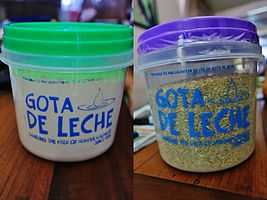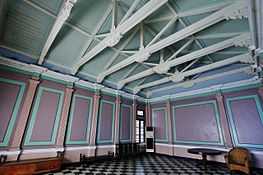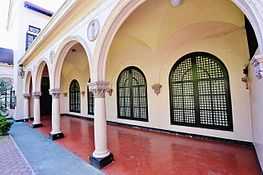Gota de Leche
| Founded | 1906 |
|---|---|
| Founder | Trinidad Rizal, Concepcion Felix |
| Type | Non-governmental organization |
| Location |
|
Area served | Philippines |
| Mission | To provide nutritional and medical needs of indigent mothers and their children |
Gota de Leche (La Protección de la Infancia Inc.) is a foundation started by Trinidad Rizal (sister of Philippine National Hero, Dr. José Rizal) and Concepcion Felix on 1906 that primarily aims to provide nutritional and medical needs of indigent Filipino mothers and their children. Gota de Leche means "drop of milk."[1] The foundation continues to deliver daily milk rations to Filipino infants
Its headquarters, the Gota de Leche building located at 859 S. Loyota St., Sampaloc, Manila, Philippines, designed by architects Juan Arellano and Arcadio Arellano (founding father of Philippine architecture), was awarded Honourable Mention by the UNESCO Asia Pacific Heritage Awards for Cultural Heritage Conservation in 2003.[2] This opened further support from the National Commission on Culture and the Arts.
The Gota de Leche Building was declared by the National Museum of the Philippines as an Important Cultural Property in August 2014.[3]
History of the foundation

Beriberi, a sickness caused by a nutritional deficit in Vitamin B1 or Thiamine, spread among Filipino women after the Philippine-American War in 1902. Hundreds of infants died before ever reaching 3 months old and it was found out that the milk coming from infected mothers were causing these deaths. This distressing condition moved a group of women to address the situation. And so in 1905, Asosación Feminista Filipina was born. It was led by Trinidad Rizal and Concepcion Felix, together with other educated women of the time.[4]
Gota de Leche was established the year after, in 1906, as station that manages the daily distribution of pasteurized cow’s milk to Filipino infants. They also provide nutrition education programs to Filipino mothers.
This project was recognized as heroic and in order for it to further succeed, the founders needed to collaborate with other professionals who were willing to lend a helping hand to the cause. The collaboration subsequently led to the formation of La Protección de la Infacia Inc., the Philippines’ first independent charity organization constituted by doctors and business leaders among others.
La Protección de la Infancia Inc. opened Gota de Leche, the brainchild of Dr. Calderon, who was inspired after witnessing the noble act of the organization.
Initially headquartered on Calle San Pedro (now Evangelista Street) in Santa Cruz near Plaza Miranda, the society moved to its present location in Sampaloc upon the completion of the Gota de Leche Building in 1917.[5]
Gota de Leche continues its charitable activities. It still provides nutritional and medical assistance to qualified Filipino mothers and children while closely monitoring their improvement. This landmark building also houses the first national center for women’s rights that provides counselling services. Other services include dental assistance, educating families on common illnesses, and playing educational games with the children.
Gota de Leche has also started their Brown Rice program, for impoverished families ensuring access to complementary food rations for both mother and child. Volunteers come and provide information on diet and keeping healthy to their parents.
In the wake of the recent disaster caused by Typhoon Yolanda, the institution has also opened its doors, literally, to those displaced by the typhoon.
The careful restoration of Gota de Leche established the importance of heritage structures and the value of historical buildings as an alternative to demolition.
Gota de Leche Building

Architect Arcadio Arellano, with help from his brother Juan Arellano, was responsible for the design of the two-storey Gota de Leche Building and was constructed out of brick masonry. The structure features a series of adjoining arches with glazed terracotta spandrels that acts as a corridor or a veranda that effectively provides shades to the large windows. In addition, a tall arched doorway serves as the main entrance with images of infants as adornments. A simple fountain with a statue can be found on the front yard.
The Ospedale degli Innocenti, an orphanage in Florence, Italy which was considered as the first renaissance building in Europe, was the inspiration for the architecture Gota de Leche Building.[6] The Gota de Leche's design has been cited as exceptional and a successful adaptation of Italian renaissance architecture that is well suited to the tropical climate here in the Philippines.
Restoration

The building inevitably showed significant deterioration and soon needed repairs or reconstructions. It was fortunate to have survived World War II as its foundation and structural system remained in good condition.
The location of Gota de Leche has been a target of real estate developers as the land values became higher. And while most heritage buildings in the area were being demolished, owners of Gota de Leche firmly decided to restore the building to its original condition.

Under the supervision of architect Augusto Villalon and Liliane Rejante Manahan acting as wall finishing consultant, the restoration project for the Gota de Leche building was buided on the principle of authenticity. They removed changes added to the building to bring it back to its original appearance, which meant tearing down an annex built on the southern end of the building and a few more structures constructed to act as classrooms to a nearby university during the 1950s. The removal of these structures restored view from the streets to the heritage building and also provided access of vehicles to the rear parking area. Landscape for the front garden was also restored.
During the 1950s, there were changes made inside the building for the installation of air condition units so the ceilings had to be dropped for this purpose. These changes were removed during the restoration project, including the replacement of the full mezzanine located on the ground floor with one that is only half the area. One can now see the completely intact original wooden ceilings, mouldings, carvings, and exposed truss work.
Almost all of the materials used during the original construction were still available in the Philippines during the restoration process. Consequently, several materials were the same as the original. The capiz (piacuna placenta) that were used for the windows were not available in Manila so they sourced it from Albay, a province in South Luzon, where the traditional skills and raw materials still exist. Construction skills were also closely monitored and workers were trained as regards the conservation process.[7]
The Gota de Leche building restoration has been completed in 2002 and has been cited as an outstanding example of heritage conservation, with an honorable mention nonetheless from UNESCO in the 2003 Asia-Pacific Heritage Awards.[7] It has also established the importance of heritage structures and their importance as an alternative to destruction.
References
- ↑ "Gota de Leche". http://gotadeleche.com/''. Retrieved 3 June 2014.
- ↑ "Winners for the 2003 UNESCO Asia-Pacific Heritage Awards". http://www.unescobkk.org/''. Retrieved 3 June 2014.
- ↑ "Declaration of the Gota de Leche Manila as an Important Cultural Property, attested to and confirmed 18th of August, 2014 by the National Museum". Gota de Leche Manila. October 2, 2014.
- ↑ "Gota de Leche". http://gotadeleche.com/''. Retrieved 3 June 2014.
- ↑ "The Philippines, the land of palm and pine : an official guide and hand book (1912)". Manila Bureau of Print. Retrieved 11 July 2014.
- ↑ Alba, Reinerio. "And You Thought You Had Not Been to Any Heritage Site". National Commission for Culture and the Arts.
- ↑ 7.0 7.1 UNESCO Bangkok http://cms2.unescobkk.org/index.php?id=2184. Missing or empty
|title=(help)
External links
| Wikimedia Commons has media related to Gota de Leche. |
Coordinates: 14°36′10″N 120°59′18″E / 14.60290°N 120.98842°E